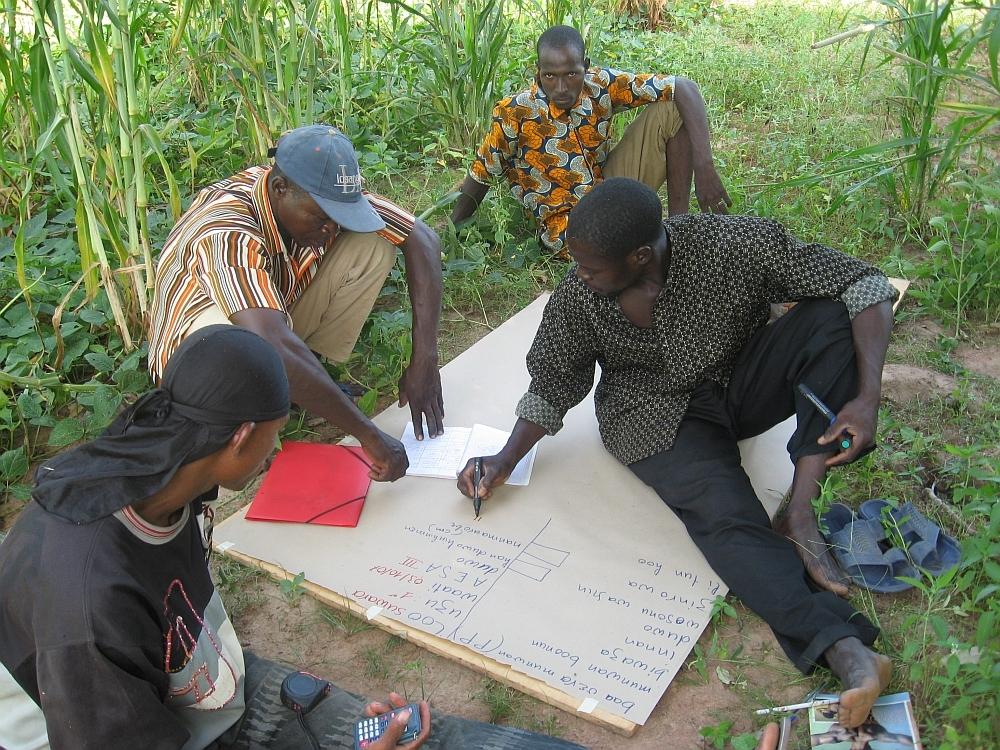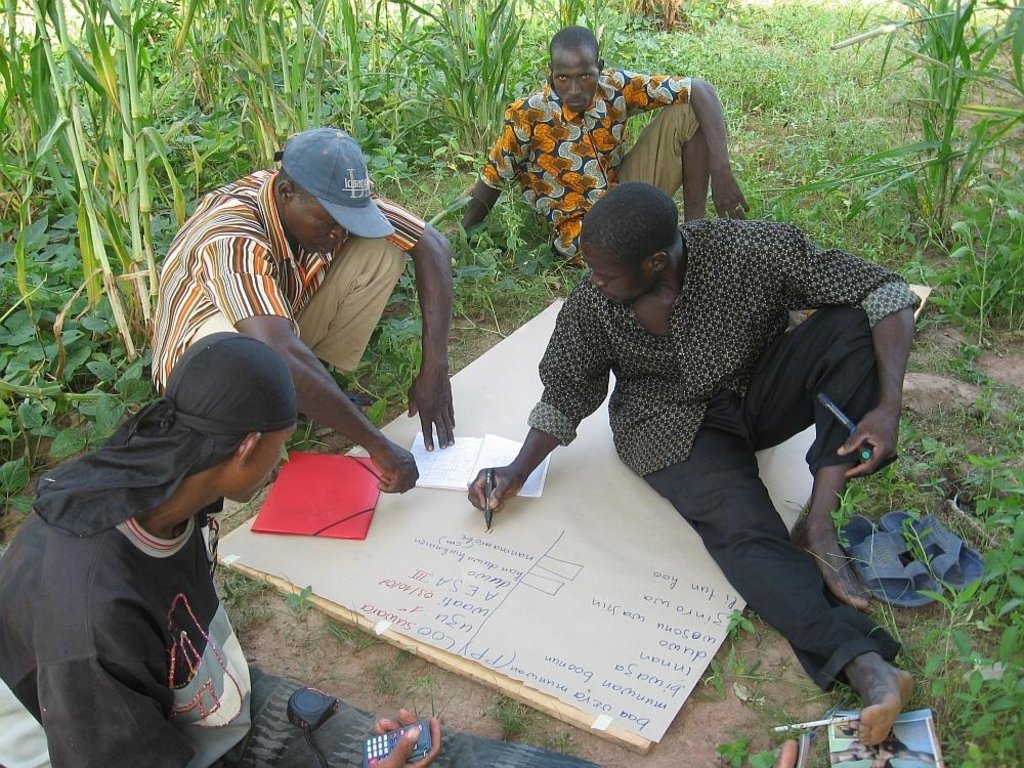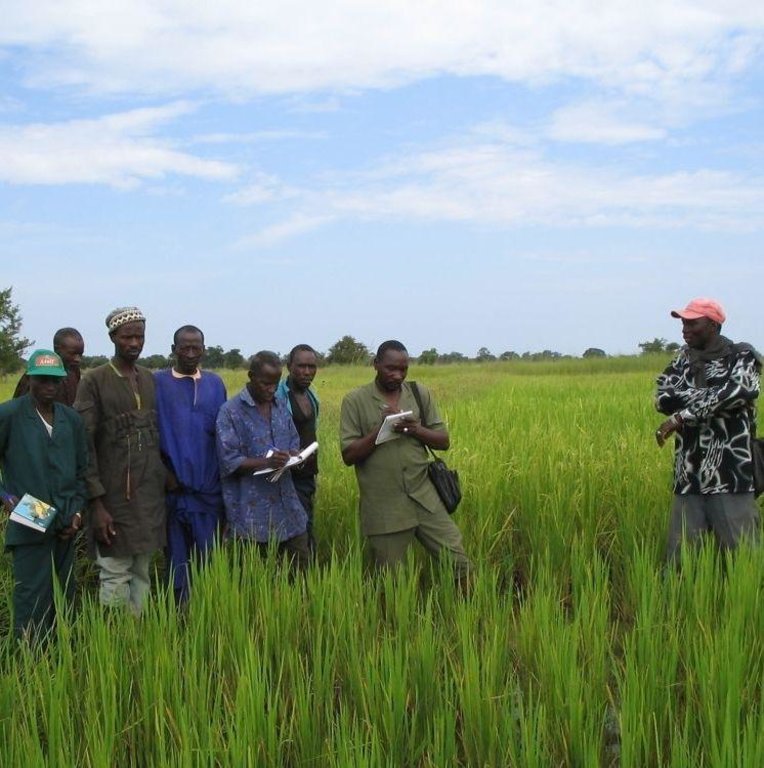Participatory Learning and Action Research for Integrated Rice Management (PLAR-IRM) [Мали ]
- Шинийг нээх:
- Шинэчлэх:
- Мэдээлэл цуглуулсан: Dieter Nill
- Редактор: –
- Хянагч: Laura Ebneter
Apprentissage participatif/recherche-action pour la gestion intégrée du riz (French)
approaches_2502 - Мали
Бүлгүүдийг үзэх
Бүгдийг харуулах Бүгдийг хаах1. Ерөнхий мэдээлэл
1.2 Арга барилыг баримтжуулах болон үнэлгээ хийхэд оролцсон хүн эсвэл байгууллагын холбоо барих хаяг
ГТМ мэргэжилтэн :
Guindo Idrissa
idrissa.guindo@helvetas.org
HELVETAS - Swiss Intercooperation
Мали
ГТМ мэргэжилтэн :
Keita Lassana
lassana.keita@helvetas.org
HELVETAS - Swiss Intercooperation
Мали
ГТМ мэргэжилтэн :
Dacko Maïga Rosaline
rosaline.dacko@helvetas.org
HELVETAS - Swiss Intercooperation
Мали
Арга барилыг баримтжуулах/үнэлэх ажилд дэмжлэг үзүүлсэн байгууллага(ууд)-ын нэр (шаардлагатай бол)
Deutsche Gesellschaft für Internationale Zusammenarbeit (GIZ) - ГерманАрга барилыг баримтжуулах/үнэлэх ажилд дэмжлэг үзүүлсэн байгууллага(ууд)-ын нэр (шаардлагатай бол)
HELVETAS (Swiss Intercooperation)1.3 WOCAT-аар баримтжуулсан өгөгдлийг ашиглахтай холбоотой нөхцөл
Мэдээллийг хэзээ (газар дээр нь) цуглуулсан бэ?
01/07/2012
Эмхэтгэгч болон гол мэдээлэгч хүн(хүмүүс) WOCAT аргачлалаар баримтжуулсан мэдээллийг ашиглахтай холбоотой нөхцлийг хүлээн зөвшөөрсөн.
Тийм
2. ГТМ Арга барилын тодорхойлолт
2.1 Арга барилын товч тодорхойлолт
An approach to develop farmers’ capacities to observe and analyse their rice management and growing practices; and to identify major constraints, then test, adapt and innovate with ways to improve integrated rice management.
2.2 Арга барилын дэлгэрэнгүй тодорхойлолт
Арга барилын дэлгэрэнгүй тодорхойлолт :
This is an educational approach for farmers, based around training groups of 20 to 25 adults and drawing on the experience of the farmers participating in the group. Farmers undertake their own analyses of the problems at hand and find their own solutions.
The PLAR-IRM approach comprises the following stages: Farmers start out by exchanging their knowledge, opinions, experiences and practices with each other and then observe crop behaviours. They compare, interpret, analyse and understand the causes for the differences observed. Next they weigh up the actions to be taken, testing new ideas and then putting them into practice. Farmers organise themselves (individually and as a group or community) to undertake the activities. Following this, functional networks are created with other farmers, extension/research services and any other support service. During the process, farmers’ learning and understanding is facilitated so that they can make better and more informed decisions, with the end goal of more productive and sustainable integrated rice management. The animators/facilitators use the learning tools provided in the PLAR-IRM training modules. These tools have been developed primarily to encourage farmers to exchange their experiences and to observe, reflect, analyse, conceptualise and test as a group. Many of the tools are based on the visualisation of phenomena and bring aspects to light that beneficiaries were previously unaware of. The 11 PLAR-IRM learning tools are: agricultural calendar, lowland area map, transect, plenary exchange session, the PLAR-IRM team’s introduction of new ideas, field observation in sub-groups, observation synthesis/Feedback, the IRM plot, trials, monitoring sheet, evaluation of gains.
Stages of implementation: 1)train the PLAR-IRM field teams, 2)devise projects for rolling out the PLAR-IRM approach more widely, 3)the approach calls for the intervention of specialist technical agents or technicians trained in PLAR-IRM, known as animators/facilitators, who help farmers to find their own solutions to problems and to increase their capacity for managing rice growing endeavours, 4)training sessions with farmers are very practical and are held in farmers’ fields. The facilitator prompts farmers to share their experiences and keeps lectures to a minimum. This stimulates farmers’ capacities to observe and interpret actions and to decide on the steps to take. Training sessions take place once a week. They begin around one month before the rice season starts and continue throughout the entire rice growing season, until after the harvest. Each session lasts one to two hours. Once the problem areas have been identified, farmers can try out new ideas. The facilitators help the farmers conduct simple trials to compare one or several new practices to their current techniques. Farmers agree among themselves on their objectives and the protocols to draw up. Practical sessions based around visits to field test sites give them the opportunity to carry out observations and adapt the new practices to their existing rice growing management context. The method is described in a manual (consisting of around 30 modules).
The lowland management committee organises teams and session calendars, and identifies plots. PLAR-IRM trainers plan modules and sessions, mobilise researchers, devise training content, conduct practical observation exercises, take notes and produce syntheses, and deploy evaluation tools for participatory learning. Farmers take part in the learning modules, apply the module learning in the field, carry out observations, contribute to decision-making, act on decisions made, perform monitoring and evaluation, and share their experience and expertise with others. The project team offers support, strategic organisation and coordination, liaises with local people, introduces the trainers, and contributes to the evaluation and capitalisation processes.
2.3 Арга барилын зурагууд
2.5 Арга барил нэвтрүүлсэн улс орон / бүс нутаг / байршил
Улс :
Мали
Улс/аймаг/сум:
Mali
Байршлын дэлгэрэнгүй тодорхойлолт:
Sikasso, Kayes, Ségou, Mopti
2.6 Арга барилыг эхлэх, дуусах огноо
Эхлэх жилийг тэмдэглэ:
2003
2.8 Арга барилын үндсэн зорилго, зорилтууд
The Approach focused mainly on SLM with other activities
The two main objectives of the technique are: 1)to develop farmers’ capacities to observe and analyse their rice management and growing practices; 2)to identify major constraints, then test, adapt and innovate with ways to improve integrated rice management.
The SLM Approach addressed the following problems: low rice production, lack of knowledge on different growing practices
2.9 Арга барилын хүрээнд хэрэгжсэн Технологи/Технологиудад дэмжсэн эсвэл саад учруулсан нөхцлүүд
ГТМ-ийн талаарх мэдлэг, техникийн дэмжлэг авах боломж
- Хазаарлалт
lack of technical knowledge on different rice growing practices
Treatment through the SLM Approach: Farmers exchange their experiences. Technical agents or technicians trained in PLAR-IRM, known as animators/facilitators, help farmers to find their own solutions to problems and to increase their capacity for managing rice growing endeavours.
3. Оролцогч талуудын оролцоо ба үүргүүд
3.1 Арга барилд оролцогч талууд болон тэдгээрийн үүргүүд
- Орон нутгийн газар ашиглагч / орон нутгийн иргэд
- ГТМ-ийн мэргэжилтэн/ хөдөө аж ахуйн зөвлөх
- ТББ
HELVETAS Swiss Intercooperation
- Засгийн газар (шийдвэр гаргагч, төлөвлөгч)
3.2 Арга барилын янз бүрийн үе шатанд орон нутгийн газар ашиглагчид / бүлэглэлүүдийг татан оролцуулах
| Орон нутгийн газар ашиглагч / орон нутгийн иргэдийн оролцоо | Хэн оролцсоныг тодорхойлж, үйл ажиллагааг тайлбарлана уу | |
|---|---|---|
| санаачлага/идэвхжүүлэлт | интерактив | |
| Төлөвлөгөө | интерактив | |
| Хэрэгжилт | өөрийн хүчийг нэгтгэсэн | |
| Мониторинг/ үнэлгээ | өөрийн хүчийг нэгтгэсэн | |
| Research | идэвхигүй |
3.4 ГТМ-ийн технологи/технологиуд сонгох шийдвэр
Хэрэгжүүлэх Технологи/Технологиудын сонголтыг хийж шийдвэр гаргасан хүнийг тодорхойлно уу:
- Газар ашиглагч дангаараа (өөрийн санаачлага)
Тайлбар :
Farmers undertake their own analyses of the problems and find their own solutions.
Decisions on the method of implementing the SLM Technology were made by by land users alone (self-initiative / bottom-up)
4. Техникийн дэмжлэг, чадавхи бүрдүүлэх, мэдлэгийн менежмент
4.1 Чадавхи бэхжүүлэх/сургалт
Газар эзэмшигчид / бусад оролцогч талуудад сургалт явуулсан уу?
Тийм
Хэн сургалтанд хамрагдсан бэ:
- Газар ашиглагчид
- хээрийн ажилтан / зөвлөх
Сургалтын хэлбэр :
- фермерээс -фермер
Хамрагдсан сэвдүүд:
Training sessions with farmers are very practical and are held in farmers’ fields. The facilitator prompts farmers to share their experiences and keeps lectures to a minimum. This stimulates farmers’ capacities to observe and interpret actions and to decide on the steps to take. Training sessions take place once a week. They begin around one month before the rice season starts and continue throughout the entire rice growing season, until after the harvest. Each session lasts one to two hours. Once the problem areas have been identified (constraints), farmers can decide to try out new ideas.
4.2 Зөвлөх үйлчилгээ
Газар ашиглагчдад зөвлөх үйлчилгээ авах боломжтой байдаг уу?
Тийм
Зөвлөх үйлчилгээ үзүүлсэн эсэхийг тогтоо:
- Газар ашиглагчийн талбай дээр
Тодорхойлолт / тайлбар:
Name of method used for advisory service: animators/facilitators; Key elements: help farmers to find their own solutions to problems and to increase their capacity for managing rice growing endeavours, facilitator prompts farmers to share their experiences and keeps lectures to a minimum , facilitators help the farmers conduct simple trials to compare one or several new practices to their current techniques; PLAR-IRM trainers plan modules and sessions, mobilise researchers, devise training content, conduct practical observation exercises, take notes and produce syntheses, and deploy evaluation tools for participatory learning.
Advisory service is very adequate to ensure the continuation of land conservation activities
4.3 Институцийг бэхжүүлэх (байгууллагын хөгжил)
Арга барилаар дамжуулан институц байгуулагдаж эсвэл бэхжсэн үү?
- Тийм, маш их
Байгууллагууд бэхжиж, үүсэн бий болсон түвшин(үүд)-г тодорхойлно уу:
- Орон нутгийн
Дэмжлэгийн төрлийг ялга:
- чадавхи бэхжүүлэх / сургалт
4.4 Мониторинг ба үнэлгээ
Мониторинг болон үнэлгээ нь арга барилын хэсэг үү?
Тийм
Тайлбар:
bio-physical aspects were ad hoc monitored by project staff, land users through measurements
technical aspects were ad hoc monitored by project staff, land users through observations
economic / production aspects were ad hoc monitored by project staff, land users through observations
economic / production aspects were ad hoc monitored by project staff, land users through measurements
management of Approach aspects were ad hoc monitored by project staff, land users through observations
bio-physical aspects were ad hoc monitored by project staff, land users through observations; indicators
There were no changes in the Approach as a result of monitoring and evaluation
There were no changes in the Technology as a result of monitoring and evaluation
4.5 Судалгаа
Судалгаа арга барилын хэсэг нь байсан уу?
Тийм
Сэдвийг тодруулна уу:
- Социологи
- Эдийн засаг/ зах зээл
- Экологи
- Технологи
Дэлгэрэнгүй мэдээллийг өгч, хэн судалгаа явуулсныг бичнэ үү:
Research was carried out both on station and on-farm
5. Санхүүгийн болон гадаад материаллаг дэмжлэг
5.2 Газар ашиглагчдад санхүүгийн / материаллаг дэмжлэг үзүүлсэн
Технологи / технологийг хэрэгжүүлэхэд газар ашиглагчид санхүүгийн / материаллаг дэмжлэг авсан уу?
Үгүй
5.3 Тодорхой зардлыг даахад чиглэсэн дэмжлэгт (хөдөлмөрийн хүчийг оролцуулаад)
- үгүй
Хэрэв газар ашиглагчийн хөдөлмөрийн хүч чухал байсан бол энэ нь аль хэлбэр байсан:
- сайн дурын
6. Нөлөөллийн дүн шинжилгээ ба дүгнэлт
6.1 Арга барилын нөлөөллүүд
Арга барил нь ГТМ-ийн технологийг хэрэгжүүлж, хадгалахад газар ашиглагчдад тусласан уу?
- Үгүй
- Тийм, бага зэрэг
- Тийм, зарим
- Тийм, их
Farmers start out by exchanging their knowledge, opinions, experiences and practices with each other and then observe crop behaviours. They compare, interpret, analyse and understand the causes for the differences observed. Next they weigh up the actions to be taken, testing new ideas and then putting them into practice.
Арга барил нь эмзэг бүлгийнхнийг нийгэм, эдийн засгийн хувьд чадавхижуулсан уу?
- Үгүй
- Тийм, бага зэрэг
- Тийм, зарим
- Тийм, их
Did other land users / projects adopt the Approach?
- Үгүй
- Тийм, бага зэрэг
- Тийм, зарим
- Тийм, их
PLAR-IRM has been rolled out in Mali, Benin, Togo, Guinea, Côte D’Ivoire, Ghana and the Gambia. In Mali, the practice has been applied in the regions of Sikasso, Kayes, Ségou and Mopti.
Did the Approach lead to improved livelihoods / human well-being?
- Үгүй
- Тийм, бага зэрэг
- Тийм, зарим
- Тийм, их
Increases in rice yields of between 25% and 40% can be achieved in lowland areas. Farmers’ rice-growing capacities are strengthened in terms of seeds, nurseries, plant care, irrigation, weed management, plant disease, harvesting, etc.
Did the Approach help to alleviate poverty?
- Үгүй
- Тийм, бага зэрэг
- Тийм, зарим
- Тийм, их
Increases in rice yields and farmers’ rice-growing capacities are strengthened
6.2 ГТМ-ийг хэрэгжүүлэх газар ашиглагчидын гол санаачилга
- үйлдвэрлэл нэмэгдсэн
- Ашиг нэмэгдсэн (боломж), зардал-үр ашгийн харьцаа сайжирсан
- well-being and livelihoods improvement
6.3 Арга барилын үйл ажиллагааны тогтвортой байдал
Газар ашиглагчид арга барилаар дамжуулан хэрэгжүүлсэн арга хэмжээг тогтвортой хадгалж чадах уу (гадны дэмжлэггүйгээр)?
- Тийм
Хэрэв тийм бол яаж гэдгийг тайлбарлана уу:
Farmers undertake their own analyses of the problems at hand and find their own solutions.
6.4 Арга барилын тогтвортой/давуу тал/боломжууд
| Эмхэтгэгч, бусад мэдээлэл өгсөн хүмүүсийн өнцгөөс тодорхойлсон давуу тал/боломжууд |
|---|
| Increases in rice yields of between 25% and 40% can be achieved in lowland areas. Farmers’ rice-growing capacities are strengthened in terms of seeds, nurseries, plant care, irrigation, weed management, plant disease, harvesting, etc. |
| The approach reinforces farming organisations’ endogenous capacities. A core of farmers master each session’s content and the PLAR-IRM modules. The method used is participatory and inclusive. Sessions are practical and take place in the field schools, which is particularly appealing to the farmers. (How to sustain/ enhance this strength: Motivating the teams of farmers is absolutely essential. Learning modules based on observation must be comprehensible and practical and delivered by competent deliverers and trainers. PLAR-IRM requires decisions made to be practical and immediately applicable. Researchers who are open to and respectful of local knowledge can facilitate the process.) |
7. Суурь мэдээлэл болон холбоосууд
7.2 Холбогдох бүтээлийн ишлэл
Гарчиг, зохиогч, он, ISBN:
Manual of Good Practices in Small Scale Irrigation in the Sahel. Experiences from Mali. Published by GIZ in 2014.
Хаанаас авч болох вэ? Зардал?
http://star-www.giz.de/starweb/giz/pub/servlet.starweb
Гарчиг, зохиогч, он, ISBN:
Defoer, T, Wopereis, M.C.S., Idinoba, P. and the PSSDRI/AKR team (2008): Curriculum d’apprentisage participatif et recherche action (APRA) pour la gestion intégrée de la culture de riz de bas-fonds (GIR) à Madagascar: Manuel du facilitateur [Participatory learning and action research (PLAR) curriculum for the integrated management of lowland rice growing (IRM) in Madagascar; Facilitator’s manual]
Хаанаас авч болох вэ? Зардал?
Africa Rice Center, Cotonou, Benin and the Aga Khan Foundation, Geneva, Switzerland. http://www.africarice.org/publications/PLAR/madagascar/preface.pdf
Холбоос ба модулууд
Бүгдийг харуулах Бүгдийг хаахХолбоосууд
Холбоос байхгүй байна
Модулууд
Модуль байхгүй байна




